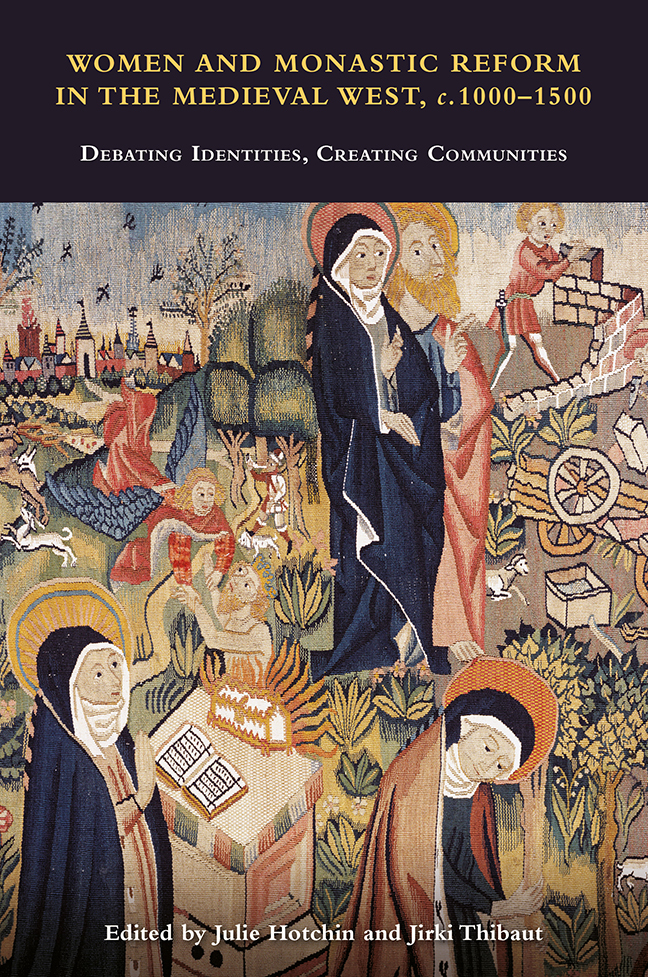 Women and Monastic Reform in the Medieval West, c.1000-1500
Women and Monastic Reform in the Medieval West, c.1000-1500 Book contents
- Frontmatter
- Dedication
- Contents
- List of Illustrations
- List of Contributors
- Acknowledgements
- List of Abbreviations
- 1 Debating Identities: Women and Monastic Reform in the Medieval West, c. 1000–1500
- 2 Liturgy and Female Monastic Hagiography Around the Year 1000: A lecture croisée of the Life of Liutrud, the Second Life of Glodesind of Metz and the So-called Pontificale Romano-Germanicum
- 3 Remakers of Reform: The Women Religious of Leominster and their Prayerbook
- 4 The Materiality of Female Religious Reform in Twelfth-Century Ireland: The Case of Co-located Religious Houses
- 5 Women as Witnesses: Picturing Gender and Spiritual Identity in a Twelfth-Century Embroidered Fragment from Northern Germany
- 6 Mulieres religiose and Cistercian Nuns in Northern Italy in the Thirteenth Century: A Choice of ‘Order’
- 7 Circulation of Books and Reform Ideas between Female Monasteries in Medieval Castile: From Twelfth-Century Cistercians to the Observant Reform
- 8 Women, Men and Local Monasticism in Late Medieval Bologna
- 9 Building Community: Material Concerns in the Fifteenth-Century Monastic Reform
- 10 Who Made Reform Visible? Male and Female Agency in Changing Visual Culture
- 11 Nuns, Cistercian Chant and Observant Reform in the Southern Low Countries
- Index
- Other volumes in Studies in the History of Medieval Religion
4 - The Materiality of Female Religious Reform in Twelfth-Century Ireland: The Case of Co-located Religious Houses
Published online by Cambridge University Press: 09 January 2024
- Frontmatter
- Dedication
- Contents
- List of Illustrations
- List of Contributors
- Acknowledgements
- List of Abbreviations
- 1 Debating Identities: Women and Monastic Reform in the Medieval West, c. 1000–1500
- 2 Liturgy and Female Monastic Hagiography Around the Year 1000: A lecture croisée of the Life of Liutrud, the Second Life of Glodesind of Metz and the So-called Pontificale Romano-Germanicum
- 3 Remakers of Reform: The Women Religious of Leominster and their Prayerbook
- 4 The Materiality of Female Religious Reform in Twelfth-Century Ireland: The Case of Co-located Religious Houses
- 5 Women as Witnesses: Picturing Gender and Spiritual Identity in a Twelfth-Century Embroidered Fragment from Northern Germany
- 6 Mulieres religiose and Cistercian Nuns in Northern Italy in the Thirteenth Century: A Choice of ‘Order’
- 7 Circulation of Books and Reform Ideas between Female Monasteries in Medieval Castile: From Twelfth-Century Cistercians to the Observant Reform
- 8 Women, Men and Local Monasticism in Late Medieval Bologna
- 9 Building Community: Material Concerns in the Fifteenth-Century Monastic Reform
- 10 Who Made Reform Visible? Male and Female Agency in Changing Visual Culture
- 11 Nuns, Cistercian Chant and Observant Reform in the Southern Low Countries
- Index
- Other volumes in Studies in the History of Medieval Religion
Summary
Reform in Medieval Ireland: An Overview
Reform in Ireland began in the early twelfth century with native Gaelic elites and clerics instigating processes to change the institutional arrangements of the church there. It is difficult to pinpoint specific reforms in Ireland, as gaps remain in the historical evidence. Despite these constraints, twelfth-century processes were a ‘transformation’ whereby episcopal authority was restructured along with dioceses, and religious renewal took the form of the introduction of continental religious orders, most notably the Cistercians. It continued throughout the twelfth century with the incoming Anglo-Norman elite undertaking their own episcopal and monastic reforms. A number of synods were held throughout the twelfth century, beginning around 1101, known through disparate sources, for example the Irish Annals, the Pontigny manuscript, genealogical compilations, contemporary episcopal documents and seventeenth-century writings based on earlier records now lost. These ecclesiastical reforms were linked to pan- European Gregorian reform. The synods were tasked with a re-organisation of the existing church structure and concerned issues such as delimiting parishes, regulating dioceses and bishops, renewing church structures, re-organising existing religious houses and the introduction of continental orders. There is a popular view that it was the invading Anglo-Normans (of England and Wales) who introduced the new reform orders to Ireland, after 1169. While this group certainly patronised such religious houses in Ireland, the first establishments of Cistercian and Augustinian religious houses had already occurred in the twelfth century, some years earlier. So the earlier twelfth-century nunneries under consideration were founded by Gaelic Irish patrons and only in the latter years of the twelfth century did Anglo-Norman patronage emerge.
There are two key figures in Ireland who are directly associated with the twelfth-century reforms: Malachy and Gille. While the status of women reli gious had long been debated within the continental church, as, for example, the correspondence between Heloise and Abelard has attested, there is yet no known female counterpart in Ireland for these male reformers. However, what is known of their lives has enabled historians to infer an outline of the status of women religious in twelfth-century Ireland. Gille, bishop of Limerick from 1106–40, wrote an important tract on the constitution of the reforming church, De Statu Ecclesiae [Concerning Church Order] dated to c. 1111, which may have been intended as a synodal discussion document.
- Type
- Chapter
- Information
- Women and Monastic Reform in the Medieval West, c.1000-1500Debating Identities, Creating Communities, pp. 81 - 97Publisher: Boydell & BrewerPrint publication year: 2023
